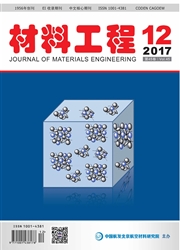

 中文摘要:
中文摘要:
研究了分别以甲烷和丙烯为前驱体对制备C/C复合材料的新型ICVI工艺致密化速率及组织结构和力学性能的影响。考察了密度与致密化时间之间的变化规律和密度分布,采用偏光显微镜和扫描电镜观察材料的组织结构和试样的断口形貌,利用三点弯曲实验测定材料的弯曲强度。实验结果表明:在致密化时间100h前,以甲烷为前驱体,C/C复合材料的致密化速率比丙烯为前驱体时低,100h后致密化速率发生逆转;以甲烷为前驱体所得C/C复合材料的密度梯度小,组织结构为粗糙层,弯曲强度为250.87MPa,模量为29.29GPa;而以丙烯为前驱体所得C/C复合材料的密度梯度大,组织结构为光滑层,弯曲强度为102.75MPa,模量为11.42GPa。因此,相对而言甲烷作为制备C/C复合材料的前驱体优于丙烯。
 英文摘要:
英文摘要:
The influence of different precursors on the densification rate, microstructures and flexural strength of C/C composites, 2-D needle punctured felt infiltrated by novel-ICVI, was investigated. The density of the resultant C/C composites was tested by volume method. The density distribution and the correlation between the density and the infiltration lime were studied. The flexural strength was determined by three-point blending tests, and the microstructures of resultant materials and the morphology of fracture surface were observed by polarized light microscopy and scanning electron microscopy respectively. The result show that the densification rate of C/C composites using methane as precursors is lower than that using propylene as precursors before 100h infiltration, while after 100h infiltration the trend is reversed. The density of C/C composites tends to distribute uniformly, the flexural strength is 250.87MPa, the flexural modular is 29.29GPa, and the texture belongs to rough laminar when methane is used as precursor. The density of C/C composites distributes unevenly, the flexural strength is 102.75MPa, the flexural modular is 11.42GPa, and the texture belongs to smooth laminar when propylene is used as precursor. Therefore, the methane is an ideal precursor for novel-ICVI Process.
 同期刊论文项目
同期刊论文项目
 同项目期刊论文
同项目期刊论文
 期刊信息
期刊信息
